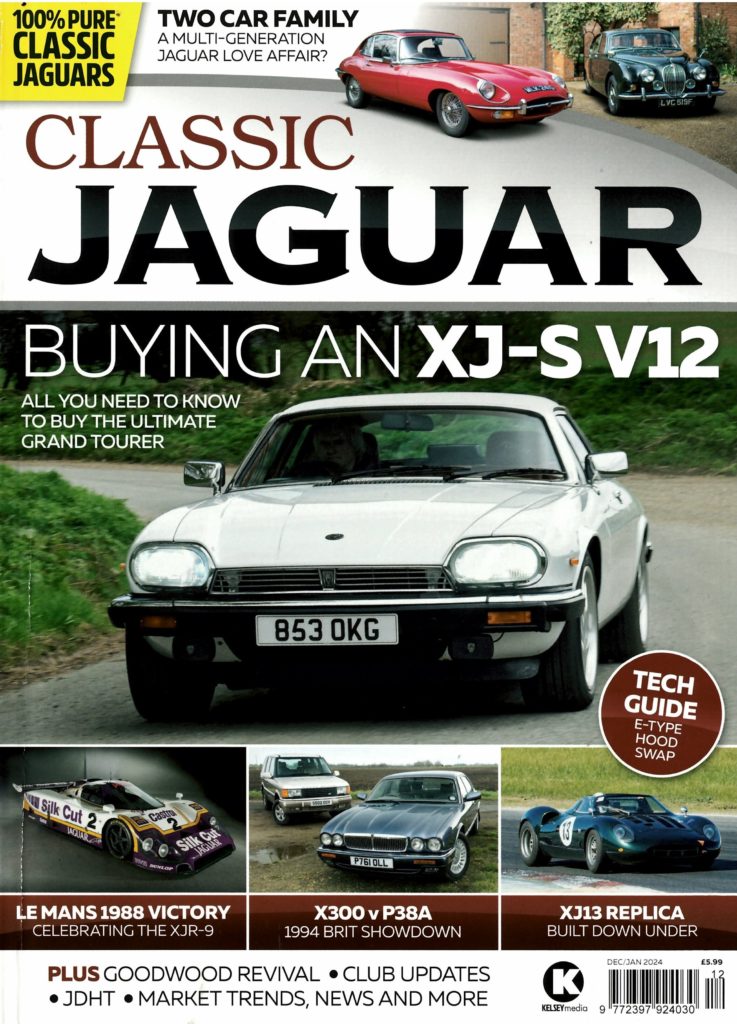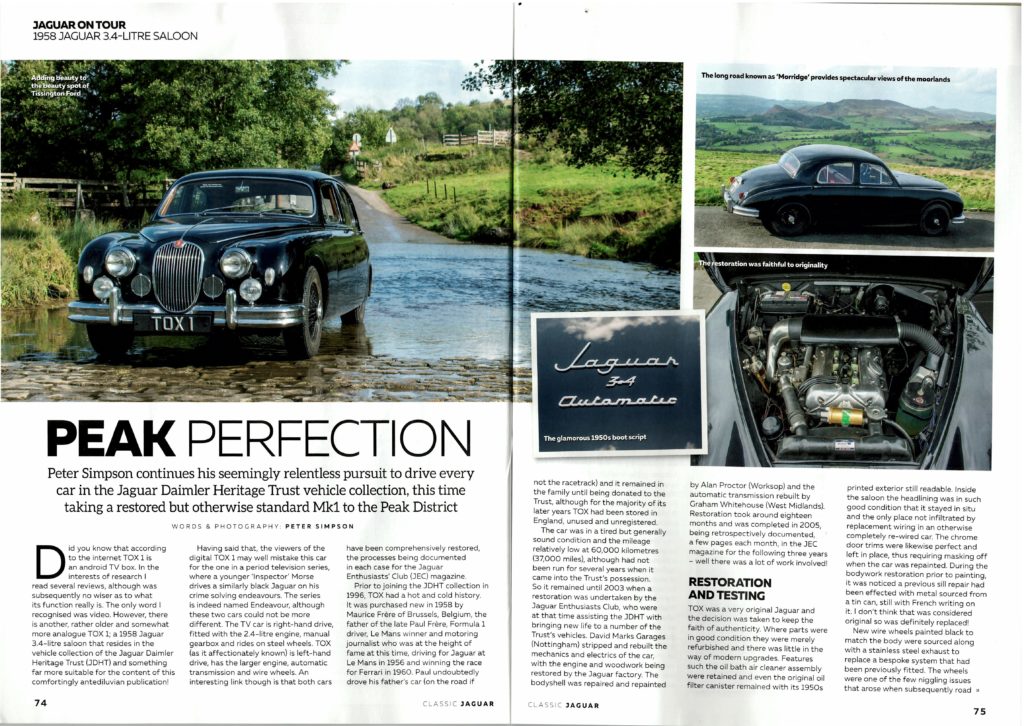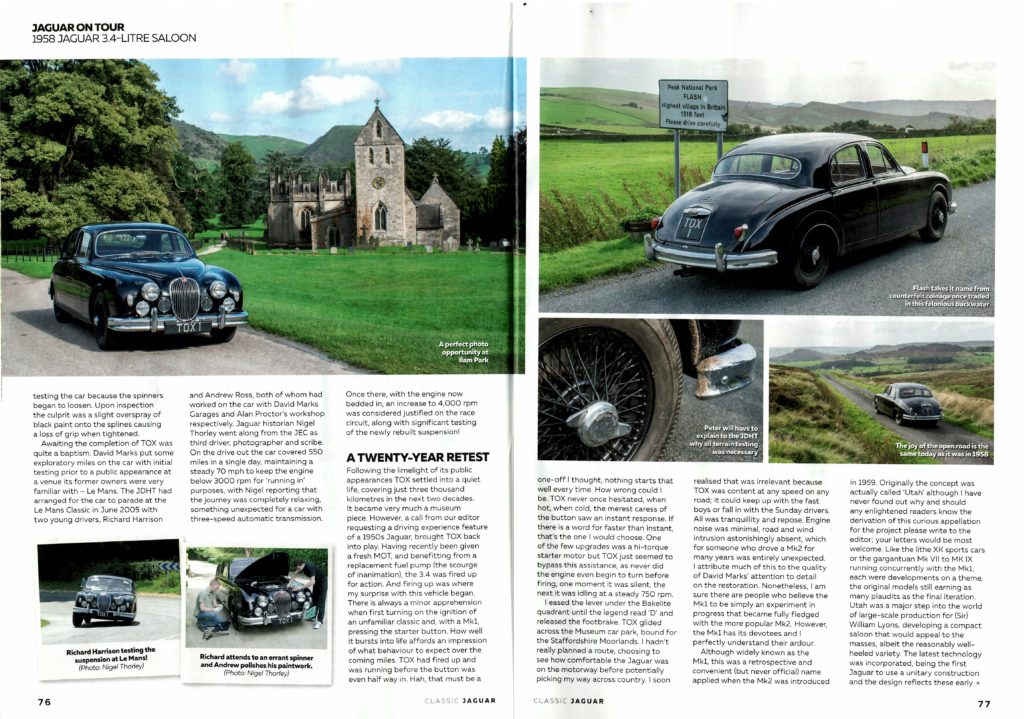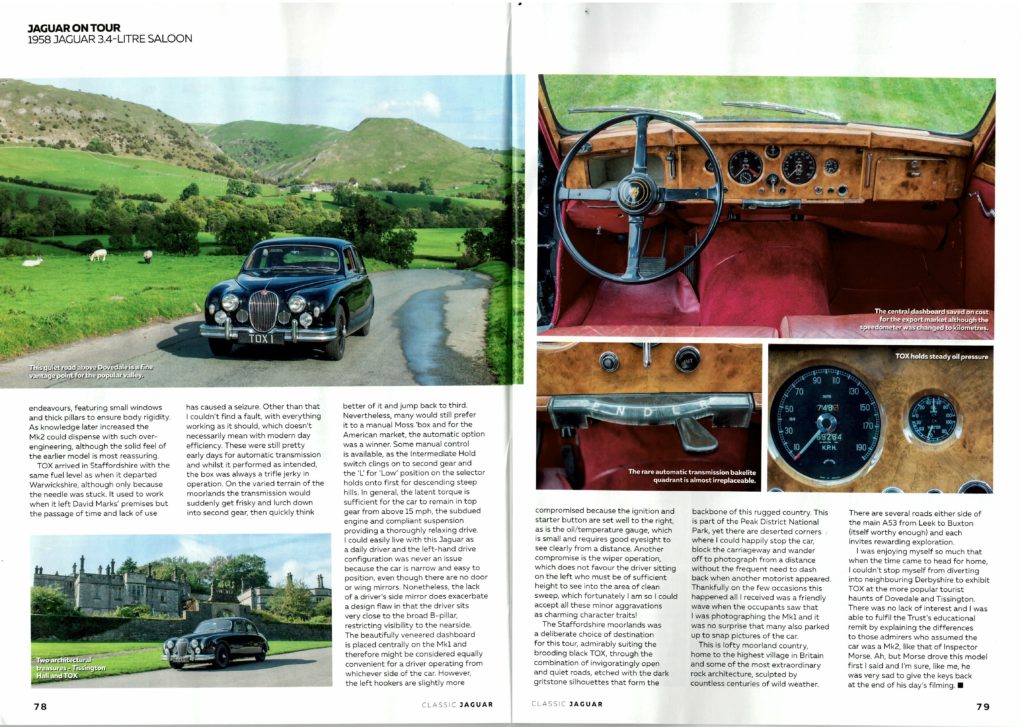Classic Jaguar Dec/Jan 2024 JAGUAR ON TOUR – 1958 Jaguar 3.4 Litre Saloon
Reproduced with permission of Classic Jaguar magazine (Dec/Jan 2024)
PEAK PERFECTION
Peter Simpson continues his seemingly relentless pursuit to drive every car in the Jaguar Daimler Heritage Trust vehicle collection, this time taking a restored but otherwise standard Mk 1 to the Peak District.
WORDS & PHOTOGRAPHY: PETER SIMPSON
Did you know that according to the internet TOX 1 is an android TV box. In the interests of research I read several reviews, although was subsequently no wiser as to what its function really is. The only word I recognised was video.
However, there is another, rather older and somewhat more analogue TOX 1; a 1958 Jaguar 3.4-litre saloon that resides in the vehicle collection of the Jaguar Daimler Heritage Trust (JDHT) and something far more suitable for the content of this comfortingly antediluvian publication!
Having said that, the viewers of the digital TOX 1 may well mistake this car for the one in a period television series, where a younger ‘Inspector’ Morse drives a similarly black Jaguar on his crime solving endeavours. The series is indeed named Endeavour, although these two cars could not be more different. The TV car is right-hand drive, fitted with the 2.4-litre engine, manual gearbox and rides on steel wheels. TOX (as it [is] affectionately known) is left-hand drive, has the larger engine, automatic transmission and wire wheels.

An interesting link though is that both cars have been comprehensively restored, the processes being documented in each case for the Jaguar Enthusiasts’ Club (JEC) magazine.
Prior to joining the JDHT collection in 1996, TOX had a hot and cold history. It was purchased new in 1958 by Maurice Frère of Brussels, Belgium, the father of the late Paul Frère, Formula 1 driver, Le Mans winner and motoring journalist who was at the height of fame at this time, driving for Jaguar at Le Mans in 1956 and winning the race for Ferrari in 1960. Paul undoubtedly drove his father’s car (on the road if not the racetrack) and it remained in the family until being donated to the Trust, although for the majority of its later years TOX had been stored in England, unused and unregistered.
The car was in a tired but generally sound condition and the mileage relatively low at 60,000 kilometres (37,000 miles), although had not been run for several years when it came into the Trust’s possession. So it remained until 2003 when a restoration was undertaken by the Jaguar Enthusiasts Club, who were at that time assisting the JDHT with bringing new life to a number of the Trust’s vehicles. David Marks Garages (Nottingham) stripped and rebuilt the mechanics and electrics of the car, with the engine and woodwork being restored by the Jaguar factory. The bodyshell was repaired and repainted by Alan Proctor (Worksop) and the automatic transmission rebuilt by Graham Whitehouse (West Midlands). Restoration took around eighteen months and was completed in 2005, being retrospectively documented, a few pages each month, in the JEC magazine for the following three years – well there was a lot of work involved!

RESTORATION AND TESTING
TOX was a very original Jaguar and the decision was taken to keep the faith of authenticity. Where parts were in good condition they were merely refurbished and there was little in the way of modern upgrades. Features such as the oil bath air cleaner assembly were retained and even the original oil filter canister remained with its 1950s printed exterior still readable. Inside the saloon the headlining was in such good condition that it stayed in situ and the only place not infiltrated by replacement wiring in an otherwise completely re-wired car. The chrome door trims were likewise perfect and left in place, thus requiring masking off when the car was repainted. During the bodywork restoration prior to painting, it was noticed a previous sill repair had been effected with metal sourced from a tin can, still with French writing on it. I don’t think that was considered original so was definitely replaced!
New wire wheels painted black to match the body were sourced along with a stainless steel exhaust to replace a bespoke system that had been previously fitted. The wheels were one of the few niggling issues that arose when subsequently road testing the car because the spinners began to loosen. Upon inspection the culprit was a slight overspray of black paint onto the splines causing a loss of grip when tightened.
Awaiting the completion of TOX was quite a baptism. David Marks put some exploratory miles on the car with initial testing prior to a public appearance at a venue its former owners were very familiar with – Le Mans. The JDHT had arranged for the car to parade at the Le Mans Classic in June 2005 with two young drivers, Richard Harrison and Andrew Ross, both of whom had worked on the car with David Marks Garages and Alan Proctor’s workshop respectively. Jaguar historian Nigel Thorley went along from the JEC as third driver, photographer and scribe. On the drive out the car covered 550 miles in a single day, maintaining a steady 70 mph to keep the engine below 3,000 rpm for ‘running in’ purposes, with Nigel reporting that the journey was completely relaxing, something unexpected for a car with three – speed automatic transmission. Once there, with the engine now bedded in, an increase to 4,000 rpm was considered justified on the race circuit, along with significant testing of the newly rebuilt suspension!

A TWENTY-YEAR RETEST
Following the limelight of its public appearances TOX settled into a quiet life, covering just three thousand kilometres in the next two decades. It became very much a museum piece. However, a call from our editor requesting a driving experience feature of a 1950s Jaguar, brought TOX back into play. Having recently been given a fresh MOT, and benefitting from a replacement fuel pump (the scourge of inanimation), the 3.4 was fired up for action. And firing up was where my surprise with this vehicle began. There is always a minor apprehension when first turning on the ignition of an unfamiliar classic and, with a Mk 1 pressing the starter button. How well it bursts into life affords an impression of what behaviour to expect over the coming miles, TOX had fired up and was running before the button was even half way in. Hah, that must be a one-off I thought, nothing starts that well every time. How wrong could I be. TOX never once hesitated, when hot, when cold, the merest caress of the button saw an instant response. If there is a word for faster than instant, that’s the one I would choose. One of the few upgrades was a hi-torque starter motor but TOX just seemed to bypass this assistance, as never did the engine even begin to turn before firing, one moment it was silent, the next it was idling at a steady 750 rpm.
I eased the lever under the Bakelite quadrant until the legend read ‘D’ and released the footbrake. TOX glided across the Museum car park, bound for the Staffordshire Moorlands. I hadn’t really planned a route, choosing to see how comfortable the Jaguar was on the motorway before potentially picking my way across country. I soon realised that was irrelevant because TOX was content at any speed on any road; it could keep up with the fast boys or fall in with the Sunday drivers. All was tranquillity and repose. Engine noise was minimal, road and wind intrusion astonishingly absent, which for someone who drove a Mk 2 for many years was entirely unexpected. I attribute much of this to the quality of David Marks’ attention to detail on the restoration. Nonetheless, I am sure there are people who believe the Mk 1 to be simply an experiment in progress that became fully fledged with the more popular Mk 2. However, the Mk 1 has its devotees and I perfectly understand their ardour.
Although widely known as the Mk 1, this was a retrospective and convenient (but never official) name applied when the Mk 2 was introduced in 1959. Originally the concept was actually called ‘Utah’ although I have never found out why and should any enlightened readers know the derivation of this curious appellation for the project please write to the editor; your letters would be most welcome. Like the lithe XK sports cars or the gargantuan Mk VII to Mk IX running concurrently with the Mk 1, each were developments on a theme, the original models still earning as many plaudits as the final iteration. Utah was a major step into the world of large-scale production for (Sir) William Lyons, developing a compact saloon that would appeal to the masses, albeit the reasonably well-heeled variety.

The latest technology was incorporated, being the first Jaguar to use a unitary construction and the design reflects these early endeavours, featuring small windows and thick pillars to ensure body rigidity. As knowledge later increased the Mk 2 could dispense with such overengineering, although the solid feel of the earlier model is most reassuring.
TOX arrived in Staffordshire with the same fuel level as when it departed Warwickshire, although only because the needle was stuck. It used to work when it left David Marks’ premises but the passage of time and lack of use has caused a seizure. Other than that I couldn’t find a fault, with everything working as it should, which doesn’t necessarily mean with modern day efficiency. These were still pretty early days for automatic transmission and whilst it performed as intended, the box was always a trifle jerky in operation. On the varied terrain of the moorlands the transmission would suddenly get frisky and lurch down into second gear, then quickly think better of it and jump back to third. Nevertheless, many would still prefer it to a manual Moss ’box and for the American market, the automatic option was a winner. Some manual control is available as the Intermediate Hold switch clings on to second gear and the ‘L’ for ’Low’ position on the selector holds onto first for descending steep hills. In general, the latent torque is sufficient for the car to remain in top gear from above 15 mph, the subdued engine and compliant suspension providing a thoroughly relaxing drive I could easily live with this Jaguar as a daily driver and the left-hand drive configuration was never an issue because the car is narrow and easy to position, even though there are no door or wing mirrors.
Nonetheless, the lack of a driver’s side mirror does exacerbate a design flaw in that the driver sits very close to the broad B-pillar, restricting visibility to the nearside. The beautifully veneered dashboard is placed centrally on the Mk 1 and therefore might be considered equally convenient for a driver operating from whichever side of the car. However, the left hookers are slightly more compromised because the ignition and starter button are set well to the right as is the oil/temperature gauge, which is small and requires good eyesight to see clearly from a distance. Another compromise is the wiper operation, which does not favour the driver sitting on the left who must be of sufficient height to see into the area of clean sweep, which fortunately I am so I could accept all these minor aggravations as charming character traits!
The Staffordshire moorlands was a deliberate choice of destination for this tour, admirably suiting the brooding black TOX, through the combination of invigoratingly open and quiet roads, etched with the dark gritstone silhouettes that form the backbone of this rugged country. This is part of the Peak District National Park, yet there are deserted corners where I could happily stop the car, block the carriageway and wander off to photograph from a distance without the frequent need to dash
back when another motorist appeared. Thankfully on the few occasions this happened all I received was a friendly wave when the occupants saw that I was photographing the Mk 1 and it was no surprise that many also parked up to snap pictures of the car. This is lofty moorland country, home to the highest village in Britain and some of the most extraordinary rock architecture, sculpted by countless centuries of wild weather. There are several roads either side of the main A53 from Leek to Buxton (itself worthy enough) and each invites rewarding exploration.
I was enjoying myself so much that when the time came to head for home, I couldn’t stop myself from diverting into neighbouring Derbyshire to exhibit TOX at the more popular tourist haunts of Dovedale and Tissington. There was no lack of interest and I was able to fulfil the Trust’s educational remit by explaining the differences to those admirers who assumed the car was a Mk 2, like that of Inspector Morse. Ah, but Morse drove this model first I said and I’m sure, like me, he was very sad to give the keys back at the end of his day’s filming.